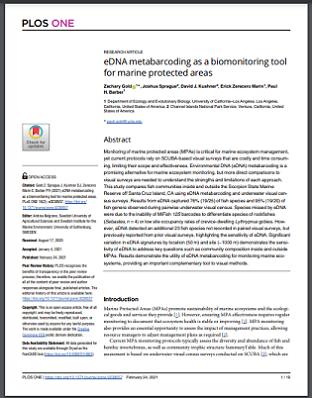
Monitoring of marine protected areas (MPAs) is critical for marine ecosystem management, yet current protocols rely on SCUBA-based visual surveys that are costly and time consuming, limiting their scope and effectiveness. Environmental DNA (eDNA) metabarcoding is a promising alternative for marine ecosystem monitoring, but more direct comparisons to visual surveys are needed to understand the strengths and limitations of each approach. This study compares fish communities inside and outside the Scorpion State Marine Reserve off Santa Cruz Island, CA using eDNA metabarcoding and underwater visual census surveys. Results from eDNA captured 76% (19/25) of fish species and 95% (19/20) of fish genera observed during pairwise underwater visual census. Species missed by eDNA were due to the inability of MiFish 12S barcodes to differentiate species of rockfishes (Sebastes, n = 4) or low site occupancy rates of crevice-dwelling Lythrypnus gobies. However, eDNA detected an additional 23 fish species not recorded in paired visual surveys, but previously reported from prior visual surveys, highlighting the sensitivity of eDNA. Significant variation in eDNA signatures by location (50 m) and site (~1000 m) demonstrates the sensitivity of eDNA to address key questions such as community composition inside and outside MPAs. Results demonstrate the utility of eDNA metabarcoding for monitoring marine ecosystems, providing an important complementary tool to visual methods.






